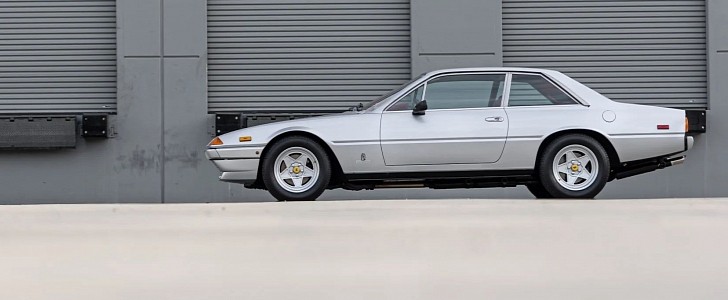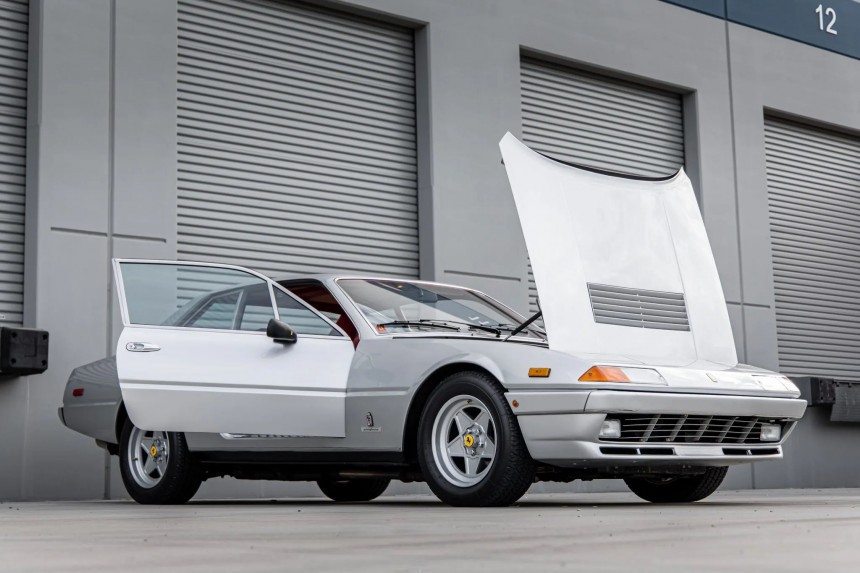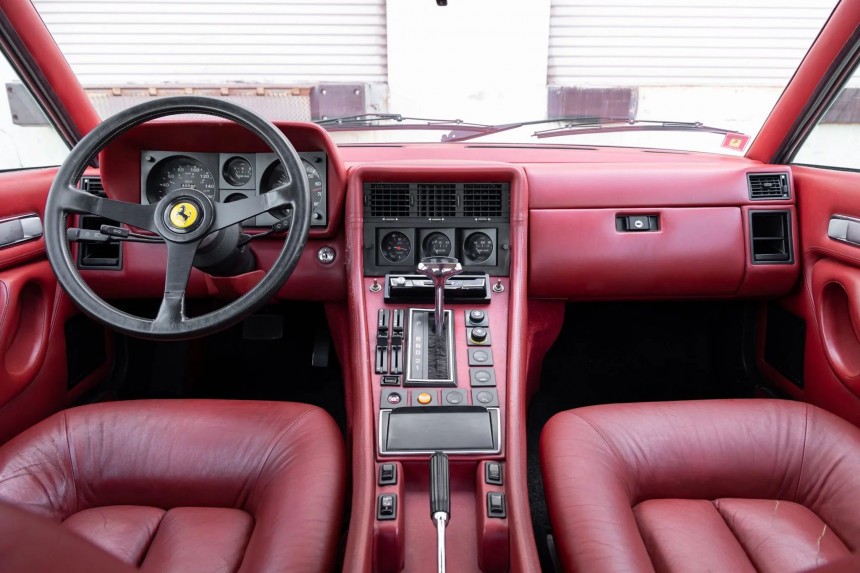Introduced in 1972 as the replacement for the 365 GTC/4, the 365 GT4 2+2 was succeeded in 1976 by the 400. Ferrari never sold this fellow in the United States due to its carbureted engine, which didn’t comply with emission regulations. Come 1979, the Prancing Horse gifted the four-seat grand tourer with mechanical fuel injection, thus giving birth to the 400i.
Offered through 1985, the 400i uses the renowned K-Jetronic system developed by German engineering and technology company Bosch. The first series-production car to feature K-Jetronic is the Porsche 911T, and the 400i is Ferrari’s first-ever production car equipped with this technology.
Named this way after the (nearly) 400 cubic centimeters of each cylinder, the 400i displaces 4,823 cubic centimeters. An evolution of the legendary V12 developed by Gioacchino Colombo in 1947, this lump is codenamed F101 D. At first glance, the only difference over the F101 C in the 400 is a letter. On the other hand, the D embodies all the changes that Maranello had to make with the adoption of Bosch K-Jetronic mechanical fuel injection.
The distributors used by the carbureted 400 were replaced by a single unit and electronic ignition supplied by Magneti Marelli. Considering that Ferrari made the switch to fuel injection for more favorable emissions test results, it shouldn’t come as a surprise that the F101 D isn’t as powerful as the F101 C. 311 ponies and 304 pound-foot (412 Nm) compared to 335 ponies and 347 pound-foot (471 Nm) is a tremendous difference, no doubt about it!
Just like the 400, the Prancing Horse’s first production car to be offered with a torque-converter automatic, the 400i could be had with a five-speed manual and a three-speed automatic. As a result, manuals were sold as the 400i GT and automatics were sold as the 400i A. Even though Ferrari says the automatic tranny is supplied by BorgWarner, bear in mind that it's designed by General Motors. The automatic in question is the long-running TH400.
Regardless of transmission, the gran turismo is rocking a limited-slip differential, a self-leveling rear axle, power steering, telescopic shocks from Koni, coil springs, unequal-length wishbones, and two anti-roll bars. The Italian outfit also provided 15- by 7-inch Cromodora five-spoke alloys, Michelin XWX rubber boots, ventilated disc brakes, and twin fuel tanks.
The 2,700-millimeter (106.3-inch) wheelbase was the longest of any production car from the Prancing Horse. By comparison, the subsequent 456 and 612 boast 4,600 mm (102.3 in) and 2,950 mm (116.1 in), respectively. Unveiled in 1979 at the Turin Motor Show, the most expensive Ferrari of that era uses the tubular steel frames of the 400 before it. The 400i is pretty similar in terms of exterior design, too, save for the redesigned taillights.
Styled by Leonardo Fioravanti at Pininfarina, the 400 series is mostly steel in terms of chassis and bodywork. The only exceptions are the aluminum hood and trunk lid. Pop-up headlights and branded mirror caps also need to be mentioned, along with leather upholstery, air conditioning, a radio, electric windows, and a three-spoke steering wheel that frames a 300-kph speedo.
The instrument cluster also consists of a tachometer that goes to 8,000 rpm and two centrally-mounted gauges for the oil pressure and water temperature. Where the center console meets the dashboard, the 400i presents you with a clock, the fuel readout, and oil temperature gauge.
Tipping the scales at 1,830 kilograms (4,034 pounds), the fuel-injected sibling is obviously heavier than the 400. In combination with the poorer output figures, the additional weight took its toll on top speed. According to Ferrari, the 400i tops 150 miles per hour (241 kilometers per hour) compared to 153 miles per hour (246 kilometers per hour) for the 400.
As expected, acceleration wasn’t particularly stellar either. Be that as it may, zero-to-60 times aren’t of the essence. Enzo Ferrari used the 400i as his company car, which speaks volumes about how the 400i is meant to be enjoyed. Famous owners also include Welsh actor Richard Burton, Led Zeppelin drummer John Bonham, and Rolling Stones bassist Bill Wyman.
Updated in time for the 1982 Paris Motor Show, the 400i was never meant to sell like hot cakes. Enzo-era Ferrari was more into racing than sales volumes, and the prohibitive price of the 400i didn’t help either. A grand total of 1,305 units were produced through 1985, of which 833 were specified with the automatic transmission designed by General Motors.
Despite its Bosch-sourced injection system, the 400i was never sold in the United States on emissions and safety grounds. American dealers had to make do with the V8-powered 308 series. Nevertheless, gray imports were in full bloom. The 400i was succeeded by the 412, which some peeps might recognize as the black-painted car from Daft Punk’s Electroma.
Named this way after the (nearly) 400 cubic centimeters of each cylinder, the 400i displaces 4,823 cubic centimeters. An evolution of the legendary V12 developed by Gioacchino Colombo in 1947, this lump is codenamed F101 D. At first glance, the only difference over the F101 C in the 400 is a letter. On the other hand, the D embodies all the changes that Maranello had to make with the adoption of Bosch K-Jetronic mechanical fuel injection.
The distributors used by the carbureted 400 were replaced by a single unit and electronic ignition supplied by Magneti Marelli. Considering that Ferrari made the switch to fuel injection for more favorable emissions test results, it shouldn’t come as a surprise that the F101 D isn’t as powerful as the F101 C. 311 ponies and 304 pound-foot (412 Nm) compared to 335 ponies and 347 pound-foot (471 Nm) is a tremendous difference, no doubt about it!
Just like the 400, the Prancing Horse’s first production car to be offered with a torque-converter automatic, the 400i could be had with a five-speed manual and a three-speed automatic. As a result, manuals were sold as the 400i GT and automatics were sold as the 400i A. Even though Ferrari says the automatic tranny is supplied by BorgWarner, bear in mind that it's designed by General Motors. The automatic in question is the long-running TH400.
The 2,700-millimeter (106.3-inch) wheelbase was the longest of any production car from the Prancing Horse. By comparison, the subsequent 456 and 612 boast 4,600 mm (102.3 in) and 2,950 mm (116.1 in), respectively. Unveiled in 1979 at the Turin Motor Show, the most expensive Ferrari of that era uses the tubular steel frames of the 400 before it. The 400i is pretty similar in terms of exterior design, too, save for the redesigned taillights.
Styled by Leonardo Fioravanti at Pininfarina, the 400 series is mostly steel in terms of chassis and bodywork. The only exceptions are the aluminum hood and trunk lid. Pop-up headlights and branded mirror caps also need to be mentioned, along with leather upholstery, air conditioning, a radio, electric windows, and a three-spoke steering wheel that frames a 300-kph speedo.
The instrument cluster also consists of a tachometer that goes to 8,000 rpm and two centrally-mounted gauges for the oil pressure and water temperature. Where the center console meets the dashboard, the 400i presents you with a clock, the fuel readout, and oil temperature gauge.
As expected, acceleration wasn’t particularly stellar either. Be that as it may, zero-to-60 times aren’t of the essence. Enzo Ferrari used the 400i as his company car, which speaks volumes about how the 400i is meant to be enjoyed. Famous owners also include Welsh actor Richard Burton, Led Zeppelin drummer John Bonham, and Rolling Stones bassist Bill Wyman.
Updated in time for the 1982 Paris Motor Show, the 400i was never meant to sell like hot cakes. Enzo-era Ferrari was more into racing than sales volumes, and the prohibitive price of the 400i didn’t help either. A grand total of 1,305 units were produced through 1985, of which 833 were specified with the automatic transmission designed by General Motors.
Despite its Bosch-sourced injection system, the 400i was never sold in the United States on emissions and safety grounds. American dealers had to make do with the V8-powered 308 series. Nevertheless, gray imports were in full bloom. The 400i was succeeded by the 412, which some peeps might recognize as the black-painted car from Daft Punk’s Electroma.















































































